| کد مقاله | کد نشریه | سال انتشار | مقاله انگلیسی | نسخه تمام متن |
|---|---|---|---|---|
| 4509117 | 1624480 | 2013 | 10 صفحه PDF | دانلود رایگان |

Loss of ecological functions due to soil degradation impacts viability of crop production systems world-wide, particularly in vegetable cropping systems commonly located in the most productive areas and characterized by intensive soil cultivation. This paper reports soil degradation caused by intensive vegetable farming, and its reversibility after two to five years of drastic changes in soil management on 16 commercial vegetable farms in south Uruguay. Changes in soil management included addition of green manures and pastures in rotations of vegetable crops, use of animal manure, and erosion control support measures (terracing, reducing slope length, re-orientation of ridges). Soil degradation caused by vegetable farming was assessed by comparing soil properties in 69 vegetable fields with values at reference sites located close to the cropped fields. Effects of the changes in soil management in the 69 fields were assessed by comparing soil properties at the start and to those at the end of the project. Compared to the on-farm reference sites, the vegetable fields contained 36% less SOC, 19% less exchangeable potassium, water stable aggregates with an 18% smaller geometric mean diameter, and 11% lower plant-available soil water capacity. Phosphorus availability was 5 times higher under vegetable cropping compared to the on-farm reference. Phaeozems (Abruptic) revealed greater degradation (44% less soil organic carbon (SOC)) than Vertisols (24% less SOC) and Phaeozems (Pachic) (21% less SOC). After two to five years of improved soil management, SOC concentration in the upper 20 cm increased by on average 1.53 g kg−1 (12%) in the Phaeozems (Abruptic) and 1.42 g kg−1 (9%) in the Phaeozems (Pachic). SOC in Vertisols increased only by 0.87 g kg−1, most likely due to their greater initial SOC concentration. Topsoil carbon sequestration was on average 3.4 Mg ha−1 in the Phaeozems. Multiple linear regression showed the quantity of incorporated amendments, the initial amount of SOC and the clay content to explain 77% of the variability in yearly changes of SOC. Available water capacity increased significantly with SOC particularly due to more water retention at field capacity, resulting in an increase in available water capacity in the first 20 cm of soil of 8.4 mm for every 10 g kg−1 of SOC increase. Results are discussed in relation to perspectives of soil degradation reversal in the long term.
► SOC depletion due to cropping was 43% in coarser and 32% in finer textured topsoils.
► SOC increase after systems re-design was 9–12% in the finer textured topsoils.
► SOC was positively correlated with available water capacity.
► AWC increased by 8.4 mm for every 10 g kg−1 of SOC increase to 20 cm depth.
► Improved cropping systems contributed to increased soil moisture supply capacity.
Journal: European Journal of Agronomy - Volume 46, April 2013, Pages 10–19